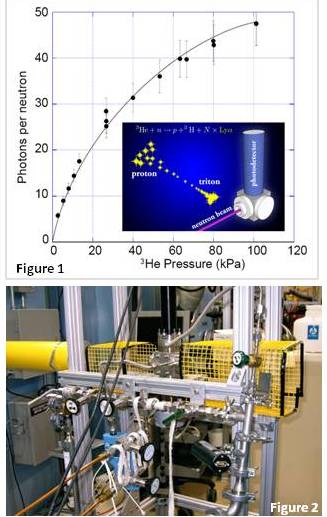| * |
|
A Novel Optical Technique for Rapid Detection of Neutrons
Summary:Almost every instrument at the NCNR and other neutron scattering facilities depends on 3He proportional tubes because of their high efficiency, good background rejection, and reliability. New research results may lead to a new detector for thermal and cold neutrons: the Lyman Alpha Neutron Detector (LAND).
Description:This detector, based on the same fundamental nuclear reaction as 3He proportional tubes, measures ultraviolet light of 122 nm wavelength produced by the reaction instead of amplifying and collecting charge. This new technique may be able to circumvent limitations of 3He proportional tubes while preserving their advantages over other techniques. The fundamental nuclear reaction that is the basis of the LAND is n + 3He ® t + p, where n is a thermal or cold neutron, 3He is the nucleus of an isotope of helium, and t and p are a tritium nucleus and a proton, respectively. The reaction releases 763 keV of energy that is shared between t and p. The velocities of the 3He atomic electrons and the outgoing t have similar magnitude, which makes it possible to have a reaction product that is a tritium atom (T) instead of a bare tritium nucleus. Our initial hypothesis was that the tritium atom was likely to be formed in an excited state that would quickly decay to its ground state, emitting one or more photons in the process. The decay from the first excited state of hydrogen to the ground state emits a characteristic photon at 121.6 nm, the "Lyman Alpha Line" (La). Because the energy neeHe ded to produce La light is 10.2 eV, there is enough energy available between the t and p to produce tens of thousands of photons. The experimental apparatus (inset, figure 1) consisted of a gas cell with a neutron-transparent window, a gas-handling system to allow evacuating and filling the cell with 3He, 4He, or a mixture of the two, and a high-efficiency Lya sensitive photodetector (a Hamamatsu R6835 "solar-blind" photomultiplier, which detects light only between 120 nm and 180 nm). The detector was installed on the 4.96 Å NG6M neutron beam line. We measured photon detection rates with the gas cell evacuated, at various pressures of 4He, and at various pressures of 3He. The 4He has essentially no interaction with neutrons, and provides a check that we were not seeing signals produced by beam-related non-neutron radiation. A series of measurements both with and without a narrow band-pass filter demonstrated that the signal was within the filter bandwidth (8.7 nm bandwidth at 119.2 nm), and thus almost certainly Lya light. Figure 2 shows the Lya photon yield per reacted neutron. If the photon production were a result of the n + 3He ® t + p reaction alone, their number per reacted neutron should be constant, independent of 3He pressure. Instead, the data fall on a curve. We take this as strong evidence that Lya photons are produced in atomic interactions with "spectator" 3He atoms occurring after the primary nuclear reaction. Preliminary theoretical calculations suggest that most of the radiation we observe comes from excitation of neutral atoms of H and T after they have been slowed to below 1 keV. At 93 kPa (700 Torr), 46 photons are produced for every neutron reacting with 3He. This high yield of photons is the main result of this investigation. One way in which the LAND can improve upon current technology is in significantly reducing the time signal per detection event. Observed pulses were in the nanosecond range, compared to microseconds for typical 3He proportional tubes. Moreover, charge collection along a high-voltage anode wire requires a cylindrical geometry that has variable efficiency. The LAND would not be constrained to this geometry. Given that the signal in pure 3He seemed to be coming from spectator atoms, we initiated a program to determine whether mixing the 3He with other gases could increase the light yield from the neutron reaction. Rough spectral measurements from some noble gases (Xe, Kr, and Ar) are consistent with the source of the light being emission from the decay of noble-gas excimers genarated by the proton and triton; the fact that essentially no signal was seen from Ne, which has an excimer emission outside of the spectral range which can be directly observed by our detector. The efficiency of the Xe, Kr, and Ar mixtures with 3He was high: the nuclear reaction energy is converted to far-ultraviolet radiation with efficiencies of up to 30 %, equivalent to tens of thousands of photons per absorbed neutron. In sum, carefully calibrated experiments on a new type of neutron detector, LAND, using a 3He gas detector near atmospheric pressure, showed that tens of Lya photons were generated per neutron absorbed. In recognition of its promise for a transformational approach to neutron detection, this result has garnered a 2008 R&D 100 award for LAND as one of the most significant technologies developed during the previous year. Further research on mixtures of 3He and other noble gases show that the light signal can be easily amplified by factors of 1000 and more. We are now seeking to extend this research to use nuclear reactions other than with 3He. Image Description: Figure 1: Lyman alpha photon yield per reacted neutron as a function of 3He pressure. The inset states the nuclear reaction and the cartoon indicates photon production and the experimental setup. Figure 2: The 'LND' detector taking data at NG6-A-beam-line in the Guide Hall |
 Photograph by: NI&D Group Lead Organizational Unit:pmlStaff:Neutron Physics GroupElectron and Optical Physics DivisionCharles W. Clark NIST Associate:Michael A Coplan
University of Maryland
coplan@umd.edu
|
